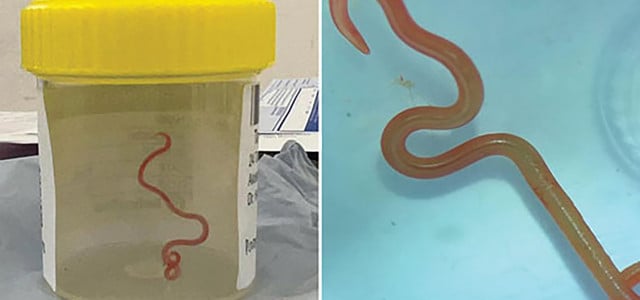
In a hospital, doctors removed a live roundworm, eight centimeters long, from the head of an Australian woman. Experts speak of the “first human case of Ophidascaris”. Worm infections of the human brain are not exceptional.
The report of a live worm discovered in the brain of an Australian caused a stir in the medical and media sectors. According to the experts, who published the finding of the parasite in a study in the journal Emerging Infectious Diseases, this is the “first human case of Ophidascaris described worldwide”.
Normally the worm of the species Ophidascaris robertsi is found in pythons. But the find is not as unusual as Spektrum classifies it. Because: Parasitic worms would invade the brain “from time to time”. In fact, this is particularly the case in countries where people lack access to hygienic standards.
Spektrum says the Australian’s symptoms, called “neural larva migrans,” are similar to those caused by roundworms that infect humans.
Some parasitic worms invade the brain
In early 2021, the patient from the state of New South Wales initially complained of weeks of abdominal pain and diarrhea, followed by a dry cough and night sweats. A year later, her symptoms also included forgetfulness and depression. The woman was then referred to Canberra Hospital. An MRI scan of her brain eventually revealed abnormalities that necessitated surgery. A biopsy eventually revealed a worm-like object. After the parasite was removed and the woman was given medication to combat any additional larvae, the symptoms disappeared again.
About a fifth of the world’s population is infected with the human infesting roundworm. People regularly become infected with roundworms through animals; These are “flexible” with their hosts, writes Spektrum.
According to the report and MSD Manual, a significant range of parasitic worms cause neurological disorders by invading the human central nervous system. An example is the raccoon roundworm, which can be responsible for meningitis – and the pork tapeworm, which causes neurological abnormalities, especially in the western hemisphere. Its larvae migrate into human tissue, including the brain or spinal cord.
Suspicion as to how the woman became infected
The python roundworm, Ophidascaris robertsi, found in the human brain is also transmitted to some mammals. Humans have not been considered endangered until now, but the number of unreported cases could be higher.
In the Australian woman’s case, the researchers have a concrete suspicion of how the worm could have gotten into her organism. The woman lives in a lake area where carpet pythons also live. Although she hasn’t had direct contact with snakes, she often collects native wild plants and grasses around the lakes to use in cooking. The researchers assume that a python may have excreted parasite eggs in its faeces on the grass. The patient likely became infected after touching the grass and transferring the worm eggs to food or kitchen utensils.
To avoid roundworms and their eggs, experts recommend washing fresh fruit and vegetables, cleaning your hands regularly and avoiding unclean drinking water.
Source: Spektrum, MSD Manual, material from dpa
Read more on Techzle\.com:
- ‘First human case’: Live worm found in woman’s brain
- Increasing corona numbers: hospital company advises flu vaccination
- Variant EG.5: Corona cases in Germany are picking up again